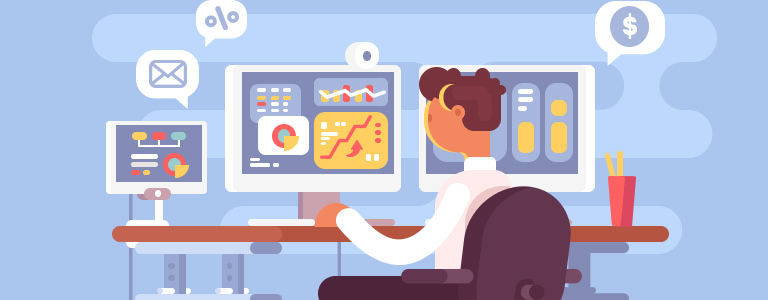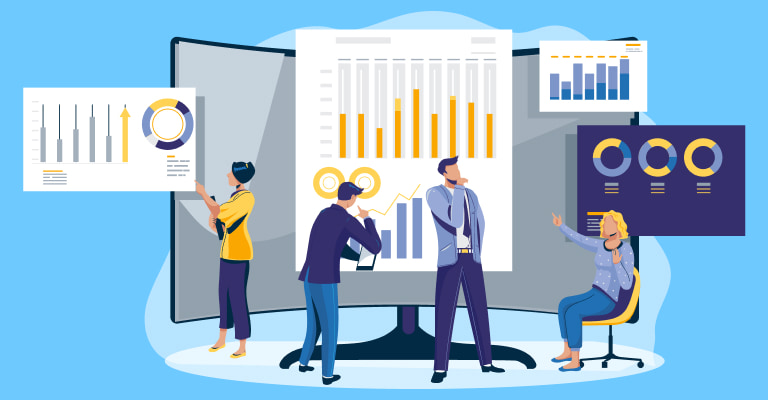
Forex is the most traded market in the world and the benefits tell it all. With forex, you gain exposure to different markets globally. Though the trading is done through the world’s leading currencies like USD, EUR, CAD and Japanese Yen, you will have access to some other global emerging markets like the Polish Zloty (PLN) and Mexican Peso (MXN).
We help all forex traders, both beginners and experienced traders get the best trading platforms for their needs. We educate our readers on all matters of trading and recommend trading apps and the best brokers.
If you’re new to forex, this guide will help you understand the whole ‘forex trading’ subject and make a cut in this business. For the advanced traders, you get to understand the tricks on how to profit more in the forex business.
In This Guide
What is Forex Trading?
The foreign exchange market, commonly regarded as forex or FX, is a decentralized market where you can buy and sell in different currencies rates. It takes place through the interbank market or over the counter instead of a centralized exchange.
You probably have participated in the foreign exchange market without knowing; when importing items or even when you bought currency while on vacation. Traders are drawn into this kind of business for many reasons including;
- A variety of currencies to trade
- The size of the forex market
- 24-hour trading
- Low transaction costs
The Forex Market
Like many other markets, the foreign exchange market is subject to demand and supply. For example, if there’s a high demand for the US dollar for other traders holding Euros, they exchange their Euros into Dollars-thus the value of Euros will go down while the Dollars will increase in value. It’s important to note that such a transaction will only affect the USD/EUR currency pair and not any other pair.
What Moves the Foreign Exchange Market?
As clearly put in the above example, demand and supply forces are among many other factors that move the FX market. Others are broad macroeconomic factors like the election of a president, other country-specific aspects like prevailing interest rate, inflation, unemployment, political instability, debt to GDP ratio, to name a few. Top traders know how to use the economic calendar to stay abreast with these and other factors that move the forex market.
What Makes Foreign Exchange Trading So Attractive?
The forex market allows trading between global banks and can be traded around the clock all days of the week. As the trading session closes in the US, the Asian banks come online and later hand over to European and UK banks.
What makes the FX market even more attractive is that it’s the most liquid market globally and with a daily trading volume of over $6.6 trillion. That means as a trader; you can enter and exit positions as you wish because there are many willing buyers and sellers for forex trading.
How Does Forex Trading Work?
You may be wondering how you can make more money through forex trading. The basics in this business are pretty straightforward. Currencies are traded in pairs like USD/EUR, EUR/AUD etc. If you think some currency’s value will go up, you buy it in what is called going “long.” On the other hand, when you think the currency you hold will depreciate, then you sell it. That’s referred to as going “short.”
Who Trades Forex?
There are two groups of traders in the FX market, speculators and hedgers.
Speculators are risk-averse and take advantage of the volatility in the exchange rates. They include large trading desks at the big banks.
The hedgers are keen to avoid extreme movements in the exchange rate. This is quite common with the giant conglomerates keen on reducing their exposure to foreign currency movements.
How Do You Read a Forex Quote?
Every trader must understand how to read a forex quote which determines the price you enter and exit the trade. Here, there’s the base currency and the variable or quote currency. Most FX markets offer up to five decimals. The number to the left of the decimal represents a unit of the variable currency, and the following are cents. The third and fourth are fractions of a cent referred to as ‘pips.’
‘Pip’ is short for a Percentage in Point, representing a small measure of the change in a currency pair. It’s measured in terms of the underlying currency or terms of the quote. It’s usually 0.0001 for US-related pairs.
Types of Currency Pairs
The USD is the most traded global currency, and that’s why most currencies are quoted against it. However, when referring to forex trading, there are several types of pairs used. Each is split into groups depending on its activity and liquidity. The pairs are divided into major, minors, and exotic pairs.
Major Currency Pairs
Majors are the most traded currencies and they’re always related to the USD. Of all the forex traders, they are the most attractive types. The most traded pair by far is the EUR/USD representing 30% of the daily forex trades. Other world’s major pairs are;
- GBP/USD
- USD/JPY
- USD/CHF
- USD/CAD
- AUD/USD
- NZD/USD
Minor Currency Pairs
Currency pairs without the USD dollar are known as crosses, while those involving a major non-USD currency are known as minor currency pairs. The most common minor pairs are those derived from Euro, Great British Pound, and Japanese Yen. For instance, pairs involving the euro are called the ‘Euro crosses.’
Here are examples of minor currency pairs;
- EUR/GBP
- EUR/JPY
- GBP/JPY
- EUR/CAD
Exotic Currency Pairs
When you trade exotic pairs, you’re exposed to a wide range of emerging and a wide range of developing economies across Africa, the Middle East, and Asia. Exotic pairs are least traded compared to the minors and majors, and the reason is obvious-the profit margin is lower. Thus they are least traded and not very liquid markets, and there’s no consistent market activity.
Exotic pairs are not widely traded, and therefore have no pros and cons associated with them. Because they’re not widely traded, they’re subject to high trading fees, but they are subject to wild price fluctuation, which is advantageous to a more experienced trader.
Following are some common exotic pairs;
- USD/SEK
- USD/NOK
- USD/TRY
- USD/MXN
- USD/ZAR
Note that local traders can often benefit from exotic paris. For instance, a Swedish trader usually keeps track of SEK while a Mexican trader keeps an eye on MXN.
Spread in Forex Trading
The difference in the sell (bid) and the ask (buy) price of a currency pair is spread. In any currency pair, there are two prices; the ask and the bid price. The asking price is the price for buying the base currency, while the bid price is the selling price of the base currency.
The pairing will tell you how much the variable currency equals a unit of the base currency.
The buying price is always higher than the selling price, just like in the ordinary goods trade market, and the underlying market is in-between. Most currency pairs are often traded without a commission, but the spread applies to the trade you place.
Instead of charging a commission, the leveraged trading providers incorporate spread to the cost of placing a trade. Here, a higher risk price which is relative to the bid price, is factored.
Several factors influence the spread size, and among these are the currency pair you’re trading and its volatility, your trade side, and the provider you use.
Spread is measured in a small unit of movement in the price of a currency pair known as ‘pips.’ A widespread means there’s a significant difference between the two prices; thus, there’s high volatility and low liquidity. On the other hand, low spread means low volatility and high liquidity and, therefore, a smaller spread cost incurred when trading a tighter currency pair.
Margin vs. Leverage in Forex Trading
Some of the most critical concepts in FX trading are leverage and margin. These tools allow traders to control trading positions more significantly in size than they should be without such. Margin is fundamentally the amount of money in your account required as a deposit to maintain a strong trading position.
Leverage allows you to control a more extensive trading position with only a small amount of your actual trading funds. However, it’s a double-edged sword in that the profits and losses will be magnified as per the degree of leverage used.
For instance, in a typical USD/CAD trade, without leverage, you’ll need up to $100,000 in account funds to buy or sell a 100,000. But with 50:1 leverage, only $2,000 of your funds will be required to open and maintain the $100,000 USD/CAD position.
Although you’re required to have 1/50 of the actual size required, any profit or loss will correspond to the $100,000 leveraged amount. In leveraged forex trading, margin privileges are provided in good faith to facilitate efficiency in the trading of currencies. It’s therefore advisable that you maintain at least the minimum required for all open positions at any given time to avoid liquidation of trading positions.
How Do I Start Forex Trading?
Before you begin trading, there are a dizzying array of variables and questions to consider. Do I trade using technical or fundamental analysis or a combination of both? Consider if you will day trade forex or take the long-term approach. In addition, look into whether you want to take a discretionary approach, or stick to the rules of a particular forex system.
When starting forex trading, you need to pay attention to the following;
- Risk management
As you start forex trading, you must have a water-tight strategy such as stop-loss and take-profit orders to implement risk management into your trading. This will enable you to effectively manage the risks thereof and reduce your exposure to the risks.
- A demo account
As a newbie, the best way to start getting experience is through a demo trading account. Here you experience live markets with live data and virtual currency. That way, you gain trading experience without risking your capital.
- A forex broker
The first step toward a successful forex trading experience is finding a suitable broker. With so many in the forex market today, getting a reliable broker can be such a headache. But some features will help you in choosing the appropriate one.
Find out some things you need to consider when picking a forex broker.
- The Forex Account Types
Before you start with a particular broker, decide on which account you wish to open. There are various forex trading accounts that you can open, like micro, mini, standard, and VIP accounts. There’s a minimum deposit and requirements that you must meet for each, and the leverage is different for each. Check out the types of accounts the broker offers and one that matches your requirements.
- The Broker types
In forex trading, brokers are the middlemen between you and the market makers. Through computer systems, they process your orders in what is called a non–dealing desk. The spreads offered to you may be fixed or variable and brokers sometimes will earn their fees as a spread percentage. The market makes the dealers with a dealing desk where orders are processed.
- Customer service
Forex trading is on a 24/5 basis, and therefore, a broker should offer uninterrupted customer service Monday through Friday. Try contacting them through all the communication channels to see how efficient they are in their response. You don’t want to keep waiting before your issues are resolved, and therefore, your initial experience should tell you whether they are the best fit or not.
- Licensing
A regulatory body licenses a reputable broker. That way, you know you’re doing business with a genuine broker and not a con. Although it’s not a guarantee for problem-free trading, it’s insurance for potential fraud issues. The registration requirements vary from country to country, and thus, you’ve to check where the company is based.
- Margin call and requirements
Before you make orders, find out the margin call requirements of the particular forex broker. The broker has a right to issue a margin call when the margin in your account is insufficient. Different brokers have different rules, with some preferring to close the deals or ask you to increase the margin. Choose the level of margin that suits your trading abilities and needs.
- Forex bonuses
A good forex broker will offer bonuses to a new client, and that will boost your initial trading capital. Some may give up to a 50% bonus on your first deposit. That means the amount is added to your account right away, and you can use it to trade. Once you reach a particular trading volume, the broker will allow you to withdraw the bonus.
Check the broker’s bonus terms and conditions carefully, so you understand the restrictions and advantages that come with the bonus.
Forex Trading Strategies
You’re into this for success, and therefore you’ve to formulate a trading strategy that works. You can employ so many strategies, but the most crucial thing is understanding and being comfortable with the strategy.
Let’s look at some of the most effective forex trading approaches
- Price action trading
With this strategy, you study historical prices, and that helps you formulate technical trading strategies. You can use this as a stand-alone technique or together with an indicator.
You can use price action trading over various periods; short, long, or medium. Your ability to use multiple frames for analysis makes price action trading of value a preference to many.
Support and resistance levels are determined through various methods used as entry/exit points. These are Fibonacci retracement, use of candle wicks, oscillators, trend identification, and indicators.
- Range trading strategy
Here, you identify the support and resistance points where traders place trades. It works perfectly in a market with low volatility and no discernible trend. The primary tool used in this trend is technical analysis.
- Trend trading strategy
This is a simple FX trading strategy used by traders of all levels of experience. Trend trading exploits a market’s directional momentum in an attempt to yield positive returns. It takes place over medium to the long-term horizon, with trends fluctuating in length.
The oscillator designates the entry points and the exit points calculated on a positive risk-reward ratio basis.
- Position trading
This is a long-term forex trading strategy focused on fundamental factors. In this strategy, smaller, more minor fluctuations aren’t considered because they don’t affect the broader market picture. This strategy is not restricted to forex trading only; it can also work in other markets, including stocks.
As aforementioned, this strategy has a long-term outlook and thus a preserve for the more persevering trader. Hence for you to forecast trading ideas, you need to understand the various factors that affect markets through technical predispositions.
In position trading, technical analysis is used to judge entry and exit points.
- Day trading strategy
This is a strategy where financial instruments are traded on the same day. Every position is closed before the market closes. It can be multiple trades or a single trade-in a day.
The trade length is abridged, like in minutes or hours, but the trade-off is opened and closed the same day.
- Swing trading
This is a speculative strategy with traders taking advantage of rang-bound and trending markets. By picking tops and bottoms, you enter short and long positions accordingly.
Swing trades are medium, and the positions are held between a few hours to a few days. Traders prefer longer-term trends because they can capitalize on the trend at multiple points.
Why You Should Trade Forex
When looking for a market to trade, you’re searching for the optimal trading conditions and chances of making a profit. See below some of the benefits of forex trading;
- The ability to go short or long
Short selling is an excellent part of forex trading, where you’re always selling one currency to buy another. A forex pair price is the worth of one unit of the base currency in the quote currency.
- The market hours
The forex market is open 24 hours five days a week. You can trade from 9 pm Sunday to 10 pm Friday GMT. Forex transactions are completed directly between parties and thus the reason for the long hours. This is done through over-the-counter (OTC) as opposed to central exchange.
Forex is a global market, and thus you can take advantage of the active sessions’ trading hours.
However, note that the trading hours will vary in March, April, October, and November.
- High liquidity forex
The foreign exchange market is the most liquid, and that means there are lots of buyers and sellers looking to trade at any given moment. High liquidity means you finish transactions easily and quickly, and thus costs and spreads are pretty low.
Conclusion
As exciting and lucrative as forex trading may be, it has its share of ‘ups’ and ‘downs.’ To play safe and maximize your profit potential, it’s prudent you get a reputable broker that will improve your trading experience. Additionally, mitigating risks using risk management controls also goes a long way to minimise losses.
Take time and study the different currencies and their performance in different markets before you start investing in forex. With the correct information and strategies, FX trading is one of the most profitable avenues for investment.
Read more about him by visiting his LinkedIn profile or contact us directly to learn more about the team.Our Author:








COMMENTS